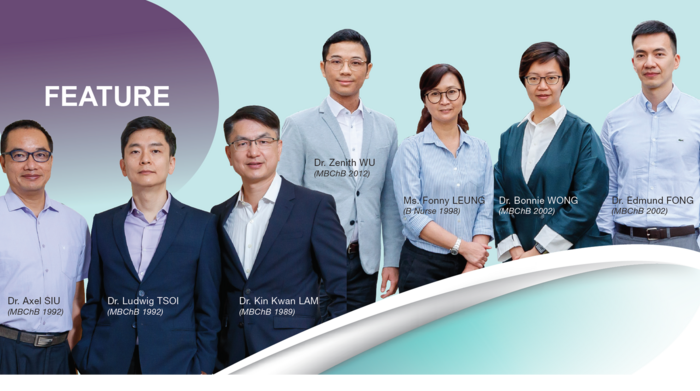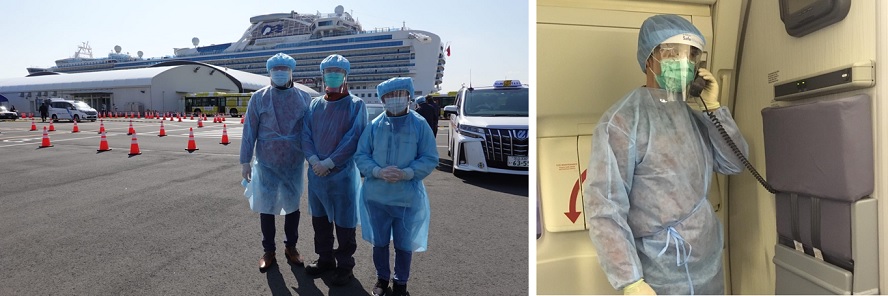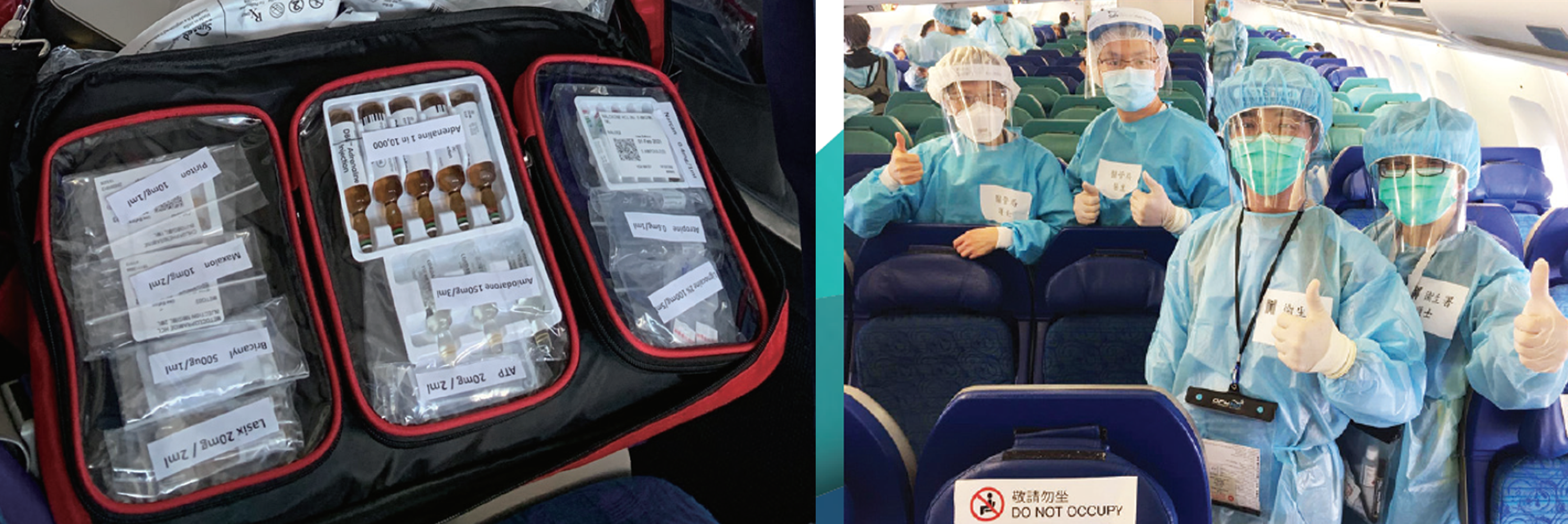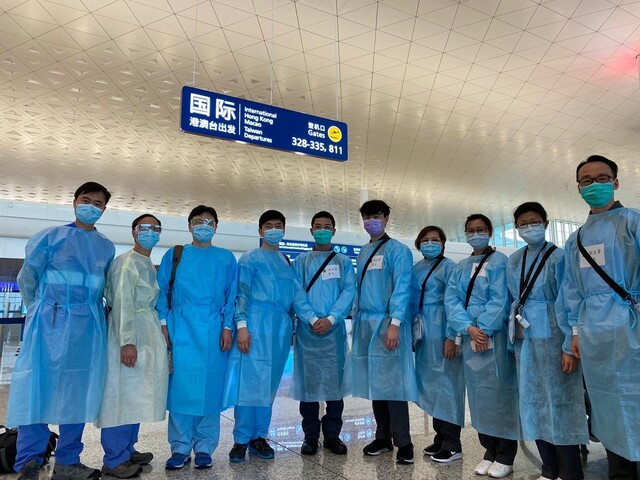
Alumni from CUHK’s Faculty of Medicine have displayed their talent, expertise and can-do spirit while assisting in the evacuations of Hong Kong residents from the Diamond Princess cruise ship in Japan and from Hubei province in mainland China. Their mission: to bring home stranded Hong Kong residents while ensuring that all those involved in the operations – from returning residents to government officials and flight crew – were protected from COVID-19.
Overcoming hurdles in Japan
At the start of the year, the Diamond Princess cruise ship, anchored in Yokohama, Japan, became the second epicentre of the COVID-19 epidemic. In February, the Hong Kong government sent three chartered flights to pick up the Hong Kong cruise passengers and bring them home.
Dr. Edmund FONG (MBChB 2002) from the Department of Health, who was responsible for planning and providing support to the mission, says: “Because COVID-19 is a novel infectious disease, there were many unknowns. It was extremely tough to formulate infection control measures. We also had very little time to prepare. I found myself thinking about the details of the mission around the clock.”
A major obstacle was the shortage of personal protective equipment at the time, adds Dr. Zenith WU (MBChB 2012), a member of the Department of Health who was involved in both the operations in Japan and Wuhan. “It was impossible to purchase the necessary gear in Japan, therefore we had to carry all the necessary supplies from Hong Kong. We needed to ensure that there would be the adequate quantity and appropriate categories of personal protective equipment for the team so that nothing would be wasted during the operation.”
In addition to equipment and material, the quarantine procedures for Hong Kong residents before and after boarding, seating and service arrangements on the aircraft were exhaustively planned, adds Dr. FONG. “The difficulties and variables our colleagues faced in Japan were unimaginable. It’s really amazing that they managed to solve all the problems that arose!”

Despite the meticulous planning, there were inevitable disruptions. Dr. Bonnie WONG (MBChB 2002) from the Department of Health, who served on the team sent in advance to Japan, laments that every aspect of their plan was fraught with uncertainties and called for agile responses. For example, 17 Hong Kong residents were unable to board the second chartered flight because they were misclassified as close contacts of confirmed cases.
Apart from figuring out what had gone wrong, Dr. WONG had to break the bad news to those affected and pacify them at the same time. She also had to explain the situation to the airline and reassure them that the safety of the passengers and crew would not be affected. All this, while ensuring that the other evacuees boarded without a hitch.
She recalls: “There were several other obstacles which almost prevented the operation from going ahead. The flight, which was originally scheduled to depart at 6 pm, eventually took off more than three hours later, barely managing to comply with flight rules. Our emotions fluctuated like a roller coaster, and only by putting ourselves in the shoes of the passengers who were denied boarding were we able to help sort out different options to assist them.”
After much back and forth with different parties involved that night, it was finally confirmed the 17 Hong Kong residents were not close contacts of COVID-19 patients. “Witnessing their gratitude to our team as they entered the departure hall with their tickets was truly memorable and a moment of relief for all,” adds Dr. WONG.
In addition to the intricacy of the operation, those involved in the evacuation faced the pressure of performing in the public glare. Dr. WU says: “With the number of cases on the cruise ship rising daily, it had caught the world's attention. When I learned I had to participate in the evacuation, I was nervous. Although my family was supportive, they were very worried. Balancing my own emotions while reassuring my family was also a big test.”
Power of prudent planning in Wuhan
The Hong Kong government also, in March, sent multiple chartered flights to Wuhan, the epicentre of the COVID-19 outbreak, to pick up Hong Kong residents stranded in Hubei province. Three emergency physicians from the Hospital Authority, Dr. Kin Kwan LAM (MBChB 1989), Dr. Axel SIU (MBChB 1992) and Dr. Ludwig TSOI (MBChB 1992) were enlisted to help in case passengers needed medical assistance during the flight.
As the outbreak had not yet been brought under control in Wuhan at the time, infection control en route was a major focus. Since the cabin of an aeroplane is enclosed and the aerosols generated by certain medical procedures could escalate the spread of viruses through the air, the team judiciously considered how to minimise the risk of infection to all passengers and cabin crew on board.
“We carefully evaluated in advance how we would deal with cases of cardiac arrest to minimise the risk of transmission of COVID-19,” Dr. LAM explains. “Firstly, aerosol-generating interventions during CPR such as ‘manual ventilation’ and ‘endotracheal intubation’ would be modified to limit the amount of aerosols generated. Secondly, since the air in commercial aircraft flows from the front to the back, we decided to resuscitate patients in cardiac arrest in the aft cabin, so that any infectious aerosols generated would very quickly be ejected from the plane.”
“Before departure, we also tried to learn as much as possible about every passenger, such as their gender, age, medical history and special needs, so that we could prepare the required medicine and equipment accordingly,” says Dr. SIU. “The flight I was responsible for had 14 pregnant women on board, each at different stages. Three of them were 36 weeks along. Although it was only a two-hour flight, we prepared for emergency labour.”

In case of such an eventuality, finding enough space for the mother and medical equipment on board the plane would be a challenge due to its confined space. Dr. SIU said the team did a great deal of preparatory and liaison work to ensure the safety of the pregnant travellers, from providing small vomit bags to large elevatable stretcher platforms.
Apart from the logistical challenges and mental stress, the operation was physically demanding. “I woke up at 4 am and met the team at North Lantau Hospital at 6 am, so that we could arrive at the airport at least an hour and a half before the 8 am take-off,” Dr. TSOI recalls. “As I was responsible for the second chartered flight that day, it was 10:30 pm by the time I touched down in Hong Kong. Due to the infection control measures, disembarkation was slower than usual. I left the airport at about 11:30 pm, then returned to North Lantau Hospital to take a shower and change my clothes, reaching home after midnight. I had been on the go and under pressure for 20 hours straight. I was really physically and mentally exhausted!” Fortunately, he exercises frequently, so was able to cope with the toll on his body.
Ms. Fonny LEUNG (B Nurse 1998), who works in the Department of Health and participated in the Hubei evacuation operation, says that this was her first experience of working outside Hong Kong. “I realised that many people were counting on us. For example, the crew of the chartered flight were very nervous and had many doubts: Had they put on the protective clothing properly? Where were the hand sanitisers? How could they move around safely? We had to fully use our professional knowledge to guide them on how to face the situation calmly and carry out infection control properly.”

Unforgettable memories
Despite the tough workload and many obstacles they faced, the alumni medical staff had many heartwarming experiences.
“There was a 70-year-old gentleman who had been diagnosed with COVID-19 on the Diamond Princess cruise ship,” Dr. WONG shares. “His condition was relatively mild, but the test always came back positive so he was hospitalised in Japan for more than a month. I kept in touch with him constantly to keep his spirits up, but instead, he shared with me beautiful pictures of sunrise that he took from his ward which overlooked the sea, and cheered me up!”
Dr. LAM treasures the expressions of the evacuees when they boarded and disembarked from the plane. “At the airport in Hubei, although everyone wore masks, we could still see the worry in their eyes. But when the flight arrived in Hong Kong, their faces immediately lit up and were full hope, and their movements became brisker.” Witnessing this change brought home to him the significance of their actions in rekindling hope among the stranded citizens.
Dr. TSOI adds, “Their smiles, sighs of relief and simple thank you’s rejuvenated me, although I was extremely exhausted at the time. Their encouragement made it all worthwhile.” Dr. WU agrees: “They had been trapped in the epidemic zone for so long, facing a great deal of stress and worry. Their relief when we reached Hong Kong told me that our efforts had not been in vain. When we set foot on Hong Kong soil again, everyone dropped their individual identities. We were all simply Hong Kong people living under Lion Rock.”

Teamwork, passion and lifelong learning
Having overcome a plethora of hurdles, all the alumni agree that teamwork is crucial to a successful outcome. Dr. FONG says this is also a belief held by CUHK alumni and Hong Kong medical staff as a whole. “Dr. WONG and I were classmates and graduated in the same year. After that, we didn’t have many opportunities to work together. On this operation, we were working partners. After she arrived in Japan, we were in constant contact, exchanging the latest news, no matter whether it was midnight or early in the morning.” As the two former classmates worked hard together, often forgoing sleep, the close relationship they developed has been an unexpected silver lining.
Dr. LAM points out: “The Hubei operation involved the evacuation of 1,027 people to Hong Kong. Only one person was later diagnosed with COVID-19. None of the other passengers on the flight was infected, proving that the infection control measures were very effective.” Dr. TSOI adds: “Shifting from the emergency room of the hospital to a narrow aircraft cabin, with limited resources to provide appropriate medical services, was a big challenge for me.” Both doctors shared that after this battle, they saw great improvements in their resuscitation and infection control capabilities.
Dr. SIU agrees: “Although I hope, from the bottom of my heart, that similar epidemics do not happen again, this experience not only allowed me to continue learning but also provided very good teaching material. I gained valuable knowledge and experience that I can pass on to the younger generation.”
Dr. WONG says the qualities that helped her overcome the many challenges that occurred were determination, perseverance, empathy and passion. She laughingly adds that although she graduated many years ago, her heart still burns with passion and this memorable journey of serving Hong Kong people abroad has overwhelmed her with joyful experiences and she has learnt many life lessons as well.
Ms. LEUNG chips in: “We just need to keep that fire burning and, at the same time, believe in our abilities!” She adds that in such unprecedented circumstances, everyone has a role to play and demonstrate their strength. “I have grown through this experience. If a similar mission arises in the future, I will not hesitate to raise my hand to participate.”
The youngest alumnus in the group, Dr. WU, who graduated from New Asia College, encourages CUHK alumni and the people of Hong Kong with the lyrics of his college song: “Let’s march through life, let’s sing when we’re tired.”
“This coronavirus pandemic is a danger to people from all walks of life around the world,” he says. “Fighting it is no longer a sprint, but a marathon. No one knows when it will end. Because this race will be long, we have to be more humane, take care of ourselves and others, move forward together and contribute what we can.” we have to be more humane, take care of ourselves and others, move forward together and contribute what we can.”

